How does a refrigerant move around a chiller or air conditioning unit to remove thermal energy from a room or refrigerator.
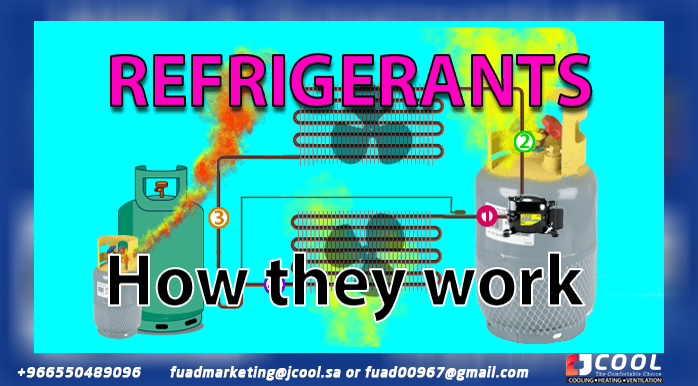 |
| How do refrigerants work |
How does a refrigerant move heat energy around a chiller or air conditioning system? It doesn't matter what type of cooling system you use, from your home fridge, to a small stand-alone air conditioning unit, to an industrial chiller. Essentially, they all work the same way, passing refrigerant between the major components of the compressor, condenser, expander, and evaporator to remove unwanted heat from one place (for example, an office) to another (for example, the air Exterior).
For more information on this, I recommend visiting the Jcool website. Jcool is your source for information and resources that can help you transition the refrigeration industry to natural, climate-friendly refrigerants. They have a deep understanding of all the new regulations and their effects, and are ready to share their insights and solutions with you. They have also made useful tools such as the Refrigerant Upgrade Guide, the Low-GWP Tool and the Coolselector 2 app available for free on their website. You can access these now by visiting Refrigerants.jcool.com.
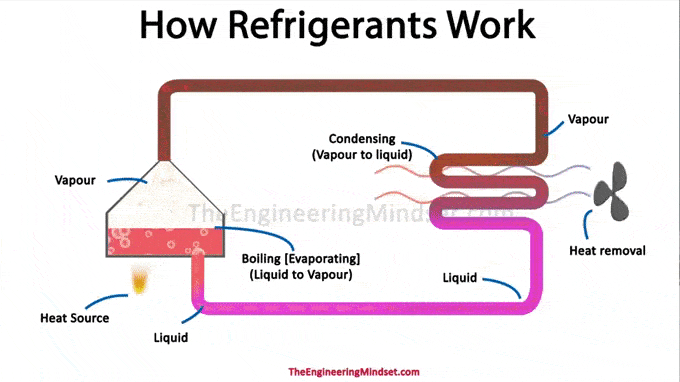 |
| Boil and evaporate the refrigerant. |
When we say “refrigerant” we mean a fluid that can easily boil from a liquid into a vapour and also be condensed from a vapour back into a liquid. This needs to occur again and again, continuously without fail.
An example of a coolant would be water. It is capable of evaporation and condensation and is easy and safe to use. It is used in absorption chillers as a refrigerant, you can read more about this type of chillers by clicking here.
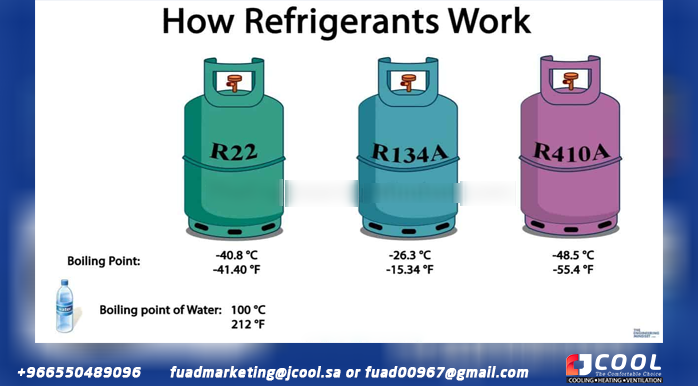 |
| Types of refrigerants and boiling points. |
Some of the most common refrigerants on the market were R22, R134A and R410A, although refrigerant laws and regulations are becoming stricter and many will be phased out in the long term. All of these common refrigerants have extremely low boiling points compared to water. This allows it to evaporate into vapor with very little heat energy applied, which means the refrigerant can extract heat faster.
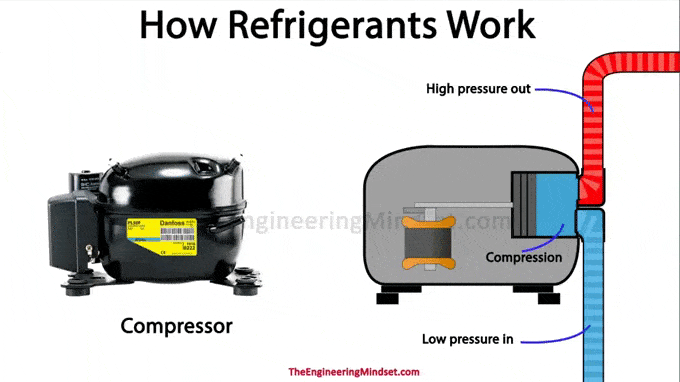 |
| how does a compressor work |
Let's see how the refrigerant moves through the system. We'll start with the compressor as it is the heart of the system, it forces refrigerant around each of the components in the refrigeration system. The refrigerant will enter as saturated vapor and is at a low temperature and low pressure. When the compressor draws in the refrigerant, it quickly compresses it, forcing the molecules to stick together so that the same number of molecules can fit into a smaller volume. All molecules bounce around constantly, and squeezing them into a smaller space causes them to collide more often as they convert their kinetic energy to heat. At the same time, all the energy supplied by the compressor is converted into internal energy in the refrigerant. This results in an increase in the internal energy, enthalpy, temperature and pressure of the refrigerant. You'll know this if you've ever used a bicycle pump, the pump gets very hot as the pressure builds.
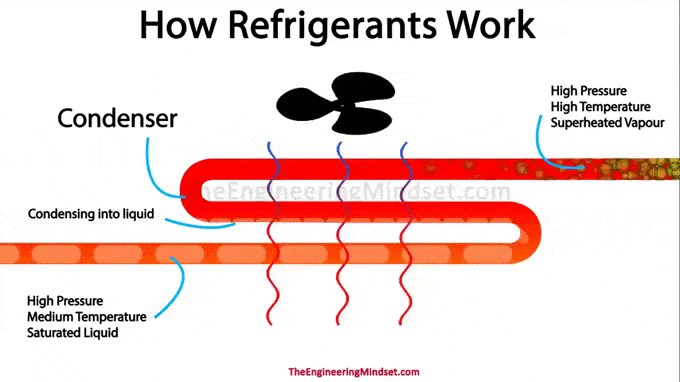 |
| how does a capacitor work |
The refrigerant now moves to the condenser. The condenser is where all the unwanted heat is expelled into the atmosphere. This will include all the heat from the building as well as the heat from the compressor. When the refrigerant enters the condenser, it must be at a higher temperature than the surrounding ambient air for heat to be transferred. The greater the temperature difference, the easier the heat transfer. The refrigerant enters as superheated vapor at high pressure and temperature, then passes through the condenser tubes. During this movement, the fans will blow air through the condenser (in an air-cooled system) to remove unwanted energy. A bit like blowing on a spoonful of hot soup to cool it down. As the air blows through the tubes, it removes heat from the refrigerant. As the refrigerant gives up its heat, it condenses into a liquid. By the time the refrigerant leaves the condenser, it will be a fully saturated liquid, still at high pressure, but slightly cooler, although it has decreased in both enthalpy and entropy.
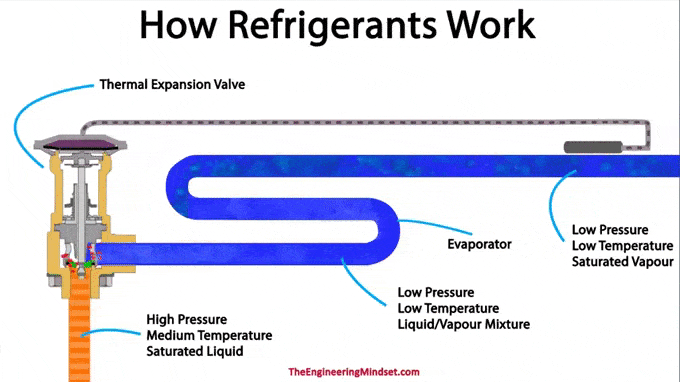 |
| how does the evaporator work |
The refrigerant then goes to the expansion valve. The expansion valve measures the flow of refrigerant through the evaporator. In this example, we are using a thermal expansion valve that holds back the refrigerant, creating a high and low pressure side. The valve will then be adjusted to allow some of the refrigerant to flow and it will be part liquid and part vapor. As it passes, it will expand in an attempt to fill the void. As it expands, the pressure and temperature of the refrigerant drop, much like holding a can of spray deodorant and pulling the trigger. The refrigerant leaves the expansion valve at low pressure and temperature and then goes directly to the evaporator.
The evaporator receives the refrigerant and another fan blows the warm air from the room through the evaporator coil. The ambient air temperature is higher than the temperature of the cold refrigerant, allowing it to absorb more energy and fully boil the refrigerant to a vapor. Just like heating a pot of water, the heat will cause the water to evaporate into steam and the steam will carry away the heat. If you were to place your hand over the rising steam, you would find that it is very hot. Although I do not recommend it and it can cause injury. Remember that we discussed the low boiling point of refrigerants earlier, so air at room temperature is enough to boil it into a vapor.
The refrigerant leaves the evaporator as vapor at low temperature and low pressure. The temperature only changes slightly, which confuses a lot of people, but the reason it doesn't increase drastically is because it undergoes a phase change from liquid to vapor, so the heat energy is used to break the bonds between molecules, but the enthalpy and entropy will increase and that's where the energy goes. The temperature will only change when the fluid is no longer undergoing a phase change.
And these are the basics of how hot refrigerants work in HVAC refrigeration systems.
Do you need help maintaining and repairing an air conditioner?
It's hard to keep cool when the air conditioning isn't working. Whether it's repairs, air conditioning, regular maintenance, or assistance with choosing your new unit, JCOOL professionals can keep you comfortable all year
Jamjoom Cooling Systems Factory (JCOOL) products (condenser coil - evaporator coil - heat exchanger - air conditioning - cold evaporator - cooler - industrial air cooler - tube bundle - air heat exchanger)
Make a reservation immediately with the maintenance team before the summer heat intensifies.
Let us help you with a lot of maintenance and installation work on your next project.
To request the service: -
Jamjoom Cooling Systems Factory
Jeddah - Second Industrial City - Street 49
WhatsApp +966 550 489 096
fuadmarketing@jamjoomarcool.com
fuadmarketing@jcool.sa
Fuad00967@gmail.com
Eng/ Abu Hussam
#heatExchangers #condensers #evaporators #coolers #coils #airDucts #chiller's #jcool #Saudi_industry #cooling #ventilation #radiators #jcool #jamjoomCoil #jamjoom_cooling_systems_factory #jamjoom #saudiArabai #coolingtowers #cooling_tower #coolingcoils #heat_exchanger #heatexchanger #coolingsystems #cooling #chiller #hvac #jamjoom_hvac #jamjoom_cooling #global_cooling_tower #Brand_Saudi_Arabia #made_in_Saudi_Arabia #🇸🇦


Comments
Post a Comment